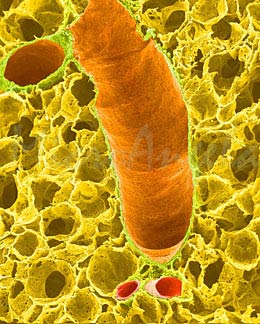

| Always a part of you |
| Most
living things are made up of one or more cells. |
 Lung
This is a high magnification SEM of a tiny portion of a rabbit lung.
Mammals, birds and reptiles have lungs, as do most amphibians and a few
kinds of fish. In humans air travels to the lungs through the nose or
mouth, down the throat and trachea (windpipe). In the chest the trachea
divides into two branches, the bronchial tubes, that go to the lungs.
|
|
 |
 |
 |
 |
 |
||||||
| Lung | Skin 1 | Skin 2 | Skin 3 | Cell Surface | ||||||
 |
 |
 |
 |
 |
||||||
| Red Blood Cells | Red Blood | Red Blood Cell | Macrophage | Sperm | ||||||
 |
 |
 |
 |
|||||||
| Muscle TEM | Golgi | Mitochondria | Synapse | |||||||
 |
 |
 |
 |
|||||||
| Cell - TEM | Cell - TEM | Stomata | Stomata 2 |
|
Copyright © 1996-2000 Tina (Weatherby) Carvalho...MicroAngela This material may not be reproduced in any form without express written permission. |